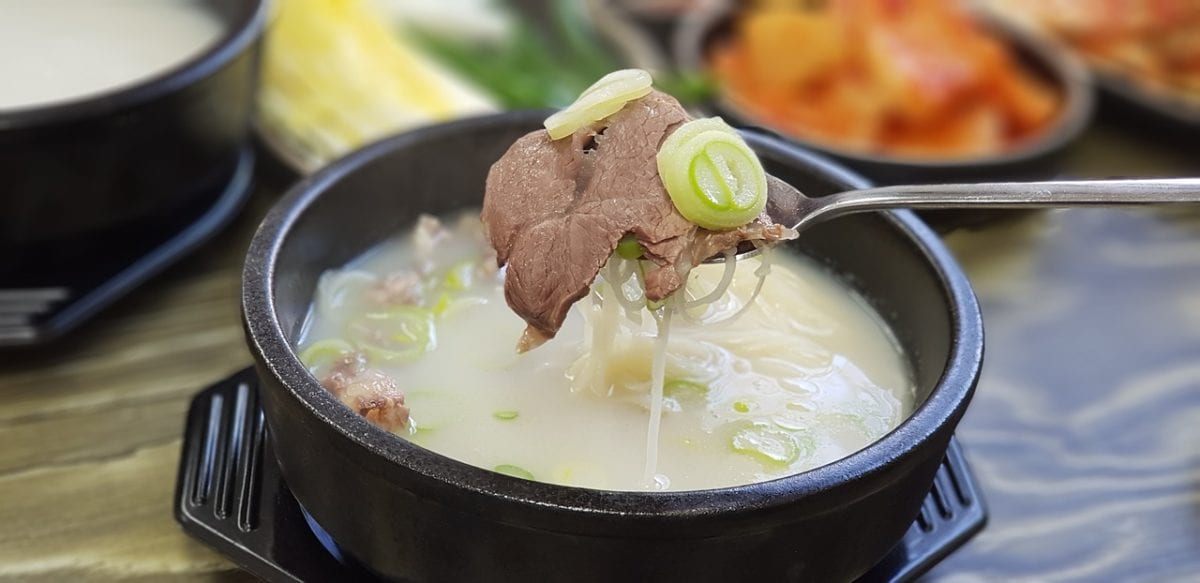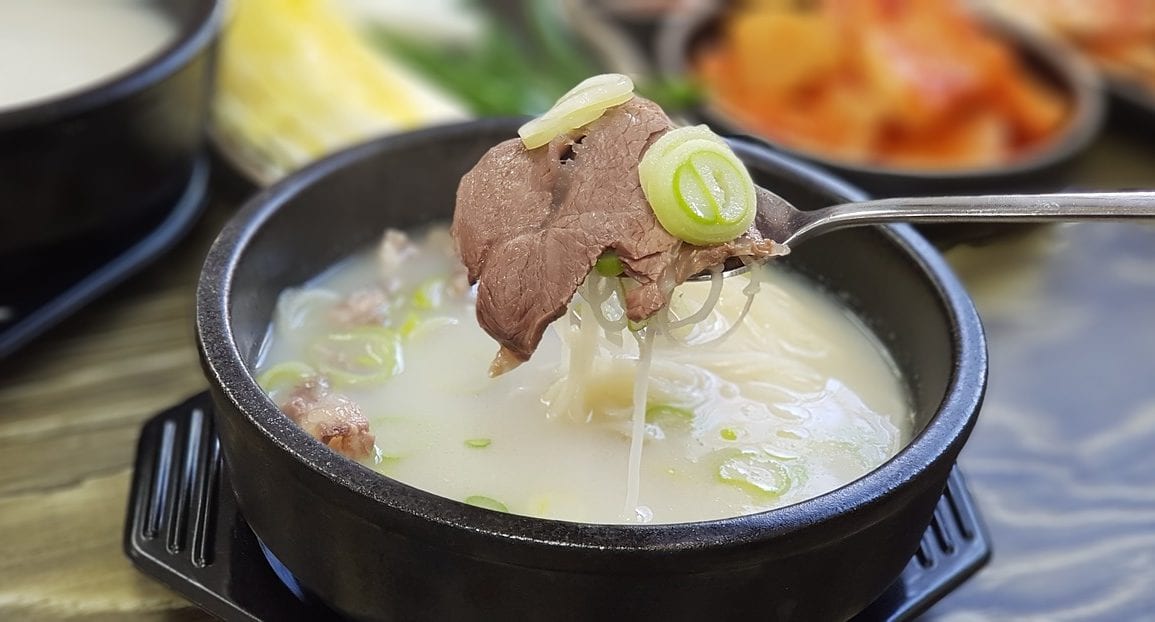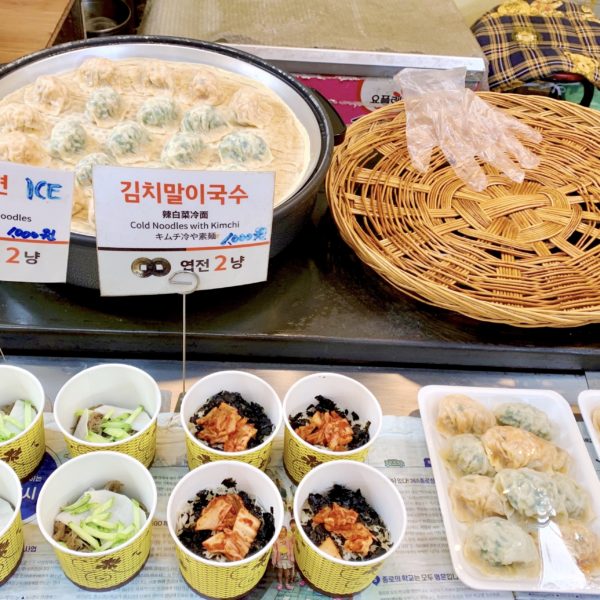When in Korea, eat as the locals do. Forgo your favorite Korean dishes and step into the realm of local specialties. While Korea is a small country, its cuisine differs within each province. Korea is divided into 9 provinces, each representing a unique, special dish. Here is your go-to guide for finding the local delicacies whilst traveling through Korea. Get your chopsticks ready and dig into some Korea’s regional specialty dishes!
List of Korea’s Regional Specialty Dishes
Seoul
Seolleongtang – Ox Bone Soup

Seolleongtang, ox bone soup, is a famous dish that is representative of Seoul. You can find this tasty broth soup all over Korea, but it is known to originate from Seoul. It is made of ox bone, brisket and seasoned to one’s preferences, usually at the table with black pepper and salt. The soup is simmered for a long period of time until the broth has reached its signature white, milky appearance. This soup dates back to the Joseon Dynasty and was eaten after ritual ceremonies for a good harvest.
Gyeonggi-do Regional Foods
Makgeolli – Rice Wine
Pocheon
Home to Sansawon, a traditional Korean liquor gallery, Pocheon has gained national recognition for their rice wine, known as makgeolli. Pocheon is also famed for their clean, mineral-rich water, which gives makgeolli from this region it’s special pizzazz. The brand Idong Makgeolli is produced using bedrock water from mountain Baek-une in Pocheon, Gyeonggi-do. Makgeolli pairs well with the Korean traditional pancake known as jeon. Definitely give it a try!
Wanggalbi – Beef Short Ribs
Suwon
Suwon is a meat-lovers paradise, as it is home to some of the best beef short rib in the country. Suwon’s ribs are celebrated not only for their tender, delicious taste but also their size. “Wanggalbi” literally translates to “king rib” and earned its name from the large size of the short ribs. Soy sauce is replaced with salt during the marinating process, preserving the crisp taste.
Budae-jjigae (부대찌개) – Army Stew
Uijeongbu
Budae-jjigae was a meal created from necessity which has flourished into a beloved national dish. Budae-jjigae is comprised of sausage, spam, instant noodle, kimchi, and other vegetables. Known as “Army Stew”, budae-jjigae originated in the city of Uijeongbu, dating back to the end of the Korean War. With a scarcity of food, locals welcomed surplus army food from U.S. bases in areas such as Uijeongbu, which were in close proximity to the bases.
Uijeongbu Budaejjigae Street is an alleyway outside Jungang Station with around ten specialty restaurants offering up local and authentic budaejjigae. It might be a little hard to find, but anything worth finding must be looked for!
Jjajangmyeon (자장면)- Black Bean Noodles
Incheon
Incheon has Korea’s largest Chinatown and is also the birthplace of the infamous jjajangmyeon. Jjajamyeon is a noodle dish topped with a thick, dark sauce of chunjang, diced pork, and vegetables. It was invented at the restaurant Gonghwachun by a Chinese immigrant from the Shandong Province of China in 1905. While many Koreans label jjajamyeong as a “Chinese” dish, it is not a traditional Chinese dish and was created right here in Korea!
Gangwon-do Regional Foods
Dakgalbi and Makguksu (닭갈비과 막국수) – Stir-fried Chicken and Noodles
Chuncheon
Chuncheon is home to the famous stir-fried chicken known as dakgalbi. If you haven’t tried this dish yet, you are missing out. The chicken is typically diced and marinated in a gochujang-based sauce. Dakgabli was created in the 1960s on the outskirts of Chuncheon as an accompanying dish to alcoholic beverages in small taverns. It was a more economical version of the pricey charcoal-grilled dishes served at the time. By the 1970s, dakgabli became known as the commoner’s galbi for its affordable price. Chuncheon has three dakgalbi streets with the most popular being Chuncheon Myeongdong Dakgalbi Street (춘천 명동 닭갈비 골목). After enjoying the tasty diced chicken don’t forget to order a side of makguksu to cool off. Makguksu is a chilled buckwheat noodle occasionally served with sugar, mustard, sesame oil or vinegar.
Sancheoneo Hoe – Red Cherry Salmon
Hwacheon
Sancheoneo Hoe, red cherry salmon, is a celebrated fish to the region of Hwacheon. Hosting the annual winter Hwacheon Sancheoneo Ice Festival, Hwacheon is famed for its salmon. The salmon is in season from December to February and is known for its fresh taste and slightly chewy texture. Check out the Hwacheon Sancheoneo Ice Festival in winter where you can find locals ice fishing on the Hwacheon Stream. If you’re feeling confident, you can even brave the icy waters and try barehanded catching a salmon of your own. Don’t worry, the staff is there to ensure even the newbies can score a catch. The fresh-caught fish can be eaten raw or on the grill.
Sundubu-jjigae (순두부 찌개) – Soft Tofu Stew
Gangneung
Are you a fan of tofu? Yes? Then head to Gangneung, the region producing some of the highest quality tofu in Korea. Sundubu-jjigae is a stew produced with curdled tofu and vegetables. It adopts a creamy texture from the tofu and pairs well with a side of white rice, like any jjigae in Korea! Gangneung houses the Chodang Dubu Village (dubu=tofu) which has over 20 restaurants serving tofu dishes. Chodang has both vegetarian dishes and meat dishes, offering fresh fish from the Sea of Japan. Gangneung’s special ingredient is the saltwater from the East Sea, which results in the soft and light texture to the tofu.
Chungcheongnam-do
Insam – Gingseng (commonly consumed in Samgyetang)
Geumsan
Geumsan is known as Korea’s birthplace of ginseng (insam) and hosts an annual Geumsan Insam Festival that draws foreigners and locals from all over Korea. Ginseng is renowned for its health benefits and is said to restore and enhance wellbeing. While you are in Geumsan, it is highly recommended to try samgyetang, ginseng chicken soup. Many Koreans eat samgyetang in the summer months to combat the heat and keep their bodies strong.
Hodu-gwaja (호두 과자) – Walnut Cookie
Cheonan
Hodu-gwaja, walnut cookie, is a Korean favorite. You can find these tasty treats in nearly every subway station. These walnut cookies were first created in 1934 by a married couple living in Cheonan. They were popularized in the 1970s and began to spread through Korea’s train stations. Hodu-gwaja’s are now beloved desserts that have gained international fame.
Chungcheongbuk-do
Dori Baengbaeng (도리뱅뱅) – Fried Fish
Cheongwon
Cheongwon is landlocked and as far from the sea as possible. While it has small streams, it lacks rivers and valleys. Therefore, locals in this region failed to have access to substantial amounts of fresh fish. They were able to catch freshwater fish, but the fish were tiny in size and weren’t good for traditional methods of cooking. Thus, was the birth of the small pan-fried fish. Dori baengbaeng are served in a round circle with garlic, ginger and chili seasonings. People generally wrap the fish in vegetables such as sesame leaves or lettuce.
Ggweong hoe (꿩회) – Raw Pheasant
Chungju
Pheasant is known for its health benefits and is usually eaten in cold months. In Chungju, pheasant can be cooked in a variety of ways, such as grilled skewers, inside dumplings, or raw with seasoning. When served raw, ggweong hoe is softer than raw fish and is known as “poultry sushi”. Some people say it aesthetically resembles a raw chicken breast. This dish is known by locals to boost energy and combat diabetes and high blood pressure.
Gyeongsangbuk-do
Daegejjim (대게찜) – Steamed King Crab
Yeongdeok
Once served to Korean kings, daegejjim, is a meal of true delicacy. Crabbers set out hunting from December to April, a month later than other regions to protect the marine state. Gangguhang Port houses almost 200 crab restaurants which draw tourists, particularly between March and April. The crabs sold on Gangguhang Port are labeled with special tags that differentiate them from crabs caught in other regions, instilling confidence in local shoppers. A local fable states that when a king from the early Joseon era first tried daege from this region, he abandoned all formalities and ate like a commoner because it was so delicious.
Jjimdak and Soju (찜닭) – Steamed Chicken
Andong
Jjimdak is steamed chicken cooked on high heat with vegetables, noodles and marinated in a ganjang-based sauce. There is speculation on the true origin of jjimdak, however, it is thought that people in the Andong market created the dish with hopes to draw more customers. Make sure you enjoy this savory dish with a side of Andong’s famed “high-proof” soju. Andong soju is respected for its quality, long history, and 45 percent proof. After your meal, make a trip to the Andong Soju Museum: Traditional Food Museum for a history lesson and some soju samples. Cheers!
Gyeongsangnam-do
Dwaeji Gukbap (돼지국밥) – Pork and Rice Stew
Dwaeji gukbap is a crowd-pleaser in Gyeongsangnam-do. Think of this dish as the Korean version of “soul food”. It is a hearty stew with pork bits and boiled for many hours, similar to that of seolleongtang. While dwaeji gukbap is representative of Busan, its origin is a bit of an enigma. Its commonly eaten in many surrounding towns in the region. The dish is served with green onion, briny baby shrimp and a red pepper paste. Many restaurants allow customers to season the stew to their liking.
Chungmu Kimbap (충무김밥) – Seaweed Rice Rolls and Octopus
Tongyeong
Chungmu kimbap is similar to traditional kimbap, except all the ingredients, minus the rice and seaweed, are served on the side. The rolls of rice and seaweed are usually served with a side of spicy, marinated baby-squid. Tongyeong is far south and close to the sea, providing an optimal fishing location. The city was once named Chungmu, which is where this famous kimbap dish gets its name. Chungmu was a fishing town surrounded by beautiful islands. The wives of fisherman wanted to create a kimbap that stayed fresher longer for their husbands at sea, so they removed the contents and served them on the side. This style gained fame with the public after a woman known as “fat granny” (뚱보할매) sold this special kimbap to locals passing by in the ferry terminal. Thus, began the tradition of Chungmu kimbap.
Agwi-jjim (아귀찜) – Braised Spicy Angler
Masan
This dish is prepared using black mouth angler fish (agwi), known to be an ugly fish. Generally speaking, “ugly food” doesn’t sell well to the public. Therefore, local fisherman from Masan’s fish markets asked cooks to create an appetizing looking dish with the agwi, in hopes to sell more fish. This was the birth of the spicy, seafood dish that is popular today. Agwi-jjim, is seasoned with hot chili pepper, ganjang, minced garlic, and chopped scallions and served with vegetables and rice.
Jeollabuk-do Region Foods
Bibimbap (비빔빕)
Jeonju
Originating from the royal cuisine, bibimbap is a fan favorite for locals and foreigners alike. While there are many variations, bibimbap will always incorporate a bed of rice topped with assorted vegetables. The history of Jeonju bibimbap dates back 200 years, being consumed since the 1800s. The creation of the dish was based on the wisdom of the Yin and Yang and the Five Elements to create a dish of perfect harmony. The rice is cooked in beef broth, which makes this bibimbap extra flavorful. Jeonju bibimbap has gained international fame and appreciation. In 2008, Jeonju City officials visited Macy’s in New York City, where they demonstrated how to make Jeonju’s sacred rice dish.
Baekhapjuk (백합죽) – Baby Clam Rice Porridge
Buan
The baekhap clam is special to the people of Gyehwado Island in Buan because it is known for living longer than other clam species. Baekhap clams can be boiled, steamed, grilled or even eaten raw. These clams are considered delicacies because only a small amount can be gathered each season. The Gyehwado people created baekhapjuk to utilize the clams and feed as many people as possible. Baekhapjuk is created by boiling rice and clams together then seasoning with sesame oil and salt.
Jeollanam-do
Daetongbap and Ddeokgalbi (대텅밥과 떡갈비 ) – Bamboo Steamed Rice and Short Rib Patty
Damyang
Daetongbap consists of rice and nuts steamed in bamboo and is a vegetarian-friendly option. Damyang is notorious for its bamboo forests and the people are known for creating high-quality bamboo bowls. Therefore, it only makes sense that the locals would steam their rice in their beloved bamboo. Daetongbap is known to have an aromatic smell whilst being high in nutritional value. Ddeokgalbi, grilled short rib patty, is another local dish to try that pairs well with the bamboo rice. When in Damyang, make sure to visit Juknokwon, a serene bamboo forest known for its massive bamboo trees.
Oritang (오리탕) – Duck Stew
Gwangju
In Gwangju, nearly 20 restaurants specializing in oritang and other duck dishes are situated on Yudong Alley in Buk-gu. Oritang is made by slowly simmering duck and vegetables to create a clear, yet flavorful stew. It is served with perilla seeds for dipping and kimchi side dishes to enhance the flavor.
Jeju-do
Heuk-dwaeji (흑돼지) – Black Pork
Jeju confidently claims to have the best barbeque in all of Korea thanks to its special species of pig, the black pig. The black pig is said to have tender meat that is more flavorful than average pork. Don’t be mistaken, the pork isn’t actually black, just the skin of the pig. While the price is a bit more expensive than other pork restaurants, it’s something you must try while you’re in Jeju. Heuk-dwaeji is commonly eaten with a salty anchovy sauce that is served in a metal cup on the grill. Jeju City houses the famous Heuk Dwaeji Street, where you can find guaranteed authentic black pork. Heuk Dwaeji Street is about 200 meters from Jungangro Junction.
Omegi-tteok (오메기떡) – Red Bean Rice Cake
Omegi-tteok is a special rice cake originating from Jeju. It is almost impossible to grow rice in Jeju, therefore farmers grow millet or barley instead. Omegi-tteok is prepared by boiling balls of this glutinous millet dough and then rolling them in bean powder or mashed red bean. While the appearance is a bit rugged on the outside, it is known to be soft yet chewy on the inside. These sweet treats can be found in traditional markets or at tourist centers, making them the perfect gift or souvenir from Jeju-do!
Mal-gogi (말고기) – Horse Meat
Jeju’s has a long history of ranches, located in the grassy plains within the middle-mountain regions. Thus, began the tradition of eating horse meat. In the past, horse meat was regarded as the highest quality cuisine and was served to royals and known to have a “lighter” taste than beef. There are various ways that horse meat can be prepared today. If you’re an adventurous eater, you can order it raw, sashimi-style. However, if you’re a little weary of trying horse, you might want to ease in and opt for a grilled preparation style.
As you can see, Korea’s cuisine is diverse and rich in tradition. Many of the dishes on this list came to fruition out of necessity and reflect the obstacles that regional locals had to overcome. Whether it is a shortage of fish or the absence of rice, Koreans have been creating innovative dishes for decades. Next time you are traveling in Korea, make sure to get a taste of the local cuisine. You won’t regret it!
Did we leave off your favorite? Let us know in the comments! Follow the 10 Magazine Food Instagram for salivating snaps from across Korea! You can also check out our article on 11 Popular Korean Foods to Try in South Korea.




